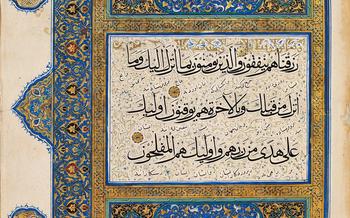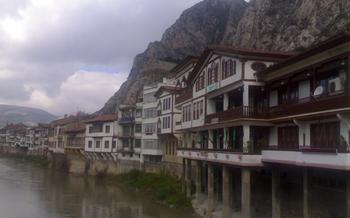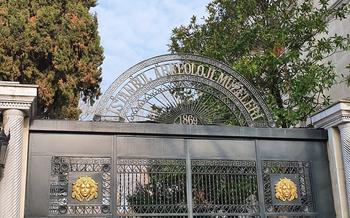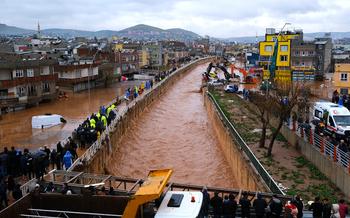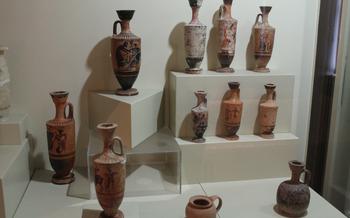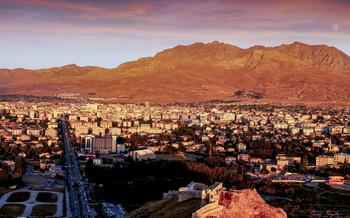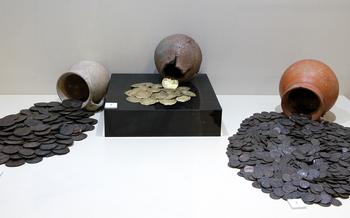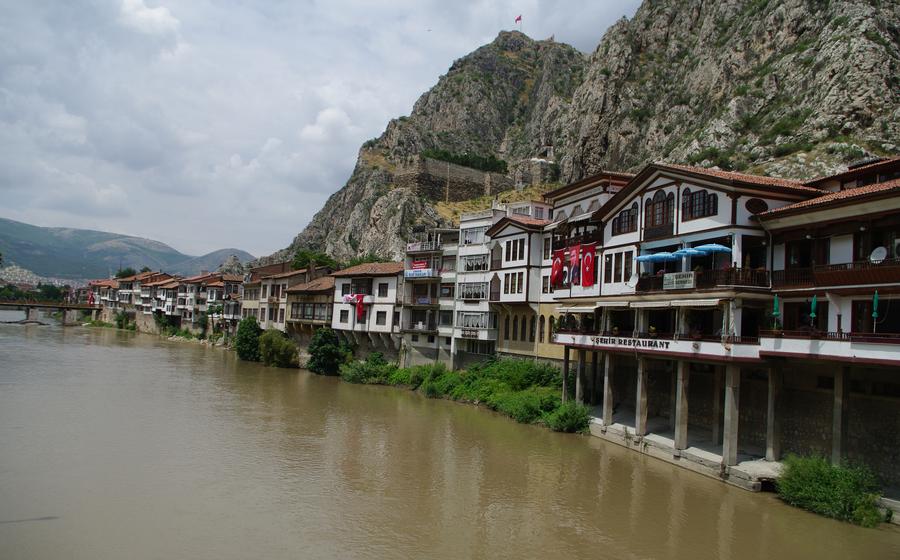
Sabuncuoğlu Museum of Medicine and Surgery
- Sabuncuoğlu Museum of Medicine and Surgery
- Life of Sabuncuoğlu
- Museum Exhibits
- The Hospital
- Medical Instruments
- Surgical Techniques
- Medical Texts
- Pharmacy
- Patient Care
- Islamic Medicine
- Cultural Significance
- Educational Value
- Research Center
- Tourism Potential
Sabuncuoğlu Museum of Medicine and Surgery
The Sabuncuoğlu Museum of Medicine and Surgery is a unique and fascinating museum dedicated to the history of medicine and surgery in the Ottoman Empire. Located in the historic city of Amasya, Turkey, the museum is housed in the former hospital of the renowned physician Şerafettin Sabuncuoğlu, who lived in the 15th century.
The museum's collection includes a wide range of medical instruments, surgical tools, and manuscripts that provide a glimpse into the world of medicine in the Ottoman Empire. Visitors can learn about the innovative surgical techniques developed by Sabuncuoğlu, as well as the traditional Turkish medicine practices that were employed at the hospital.
The museum is also a valuable resource for researchers studying the history of medicine. It houses a collection of Sabuncuoğlu's medical manuscripts, which are considered to be among the most important medical texts of the Ottoman period. These manuscripts provide detailed descriptions of surgical techniques, medical treatments, and medicinal plants, and they offer a unique perspective on the development of medicine in the Islamic world.
Life of Sabuncuoğlu
Who was he? Sabuncuoğlu Cerrah Mehmed bin Ali (also known as Shams al-Din) was a trailblazing physician, surgeon, and medical scholar born in Amasya, Turkey, in the 15th century. He stands as one of the most influential figures in the history of medicine, leaving an indelible mark on surgical practices and medical knowledge during the Ottoman Empire.
Growing up in a family immersed in the healing arts, Sabuncuoğlu demonstrated an insatiable thirst for knowledge from a young age. He embarked on extensive travels throughout the Middle East, diligently studying under renowned masters and absorbing the wisdom of various medical traditions. His pursuit of knowledge led him to Damascus, where he became a disciple of the celebrated physician Ibn al-Nafis, further honing his skills and expertise in the field.
His contributions to medicine Sabuncuoğlu's contributions to medicine were revolutionary for his time. He emphasized the importance of observation and experimentation, challenging prevailing theories and advocating for a more evidence-based approach to medical practice. His surgical techniques, meticulously documented in his medical texts, were groundbreaking and demonstrated a remarkable understanding of human anatomy and physiology.
Among his most notable contributions was his pioneering work on plastic surgery, particularly rhinoplasty (nose reconstruction). Sabuncuoğlu developed innovative techniques for reconstructing noses damaged due to injury or disease, using local flaps and grafts to achieve remarkable results. His expertise in this field earned him the title of "Father of Plastic Surgery."
His legacy Sabuncuoğlu's legacy extends far beyond his lifetime. His medical manuscripts, including the renowned "Cerrahiyyetu'l-Haniyye" (Imperial Surgery), became essential references for surgeons and physicians throughout the Ottoman Empire and beyond. His teachings and techniques were meticulously recorded and passed down through generations, influencing medical practices for centuries.
Today, Sabuncuoğlu is recognized as one of the most prominent figures in the history of medicine. His contributions to surgery, plastic surgery, and medical knowledge have left a lasting impact on the field, and his work continues to inspire and inform modern medical practices.
Museum Exhibits
The Sabuncuoğlu Museum of Medicine and Surgery offers a comprehensive look into the history of medicine and surgery in Turkey. Visitors can explore a variety of exhibits that showcase the contributions of Sabuncuoğlu and other notable physicians from the region. The museum's collection includes a wide range of artifacts, including medical instruments, surgical tools, and ancient manuscripts.
Highlights of the Collection
Some of the highlights of the museum's collection include:
-
A replica of Sabuncuoğlu's operating table: Visitors can see a life-size replica of the operating table that Sabuncuoğlu used to perform surgeries. The table is made of wood and features a number of adjustable parts, which allowed Sabuncuoğlu to position his patients in different ways.
-
A collection of surgical instruments: The museum houses a large collection of surgical instruments that were used by Sabuncuoğlu and other surgeons from the region. The instruments are made from a variety of materials, including metal, bone, and ivory. They include scalpels, forceps, saws, and needles.
-
Sabuncuoğlu's medical manuscripts: The museum also houses a number of Sabuncuoğlu's medical manuscripts. These manuscripts contain detailed descriptions of surgical techniques, medical treatments, and medicinal plants. They are a valuable source of information for scholars who are studying the history of medicine.
Interactive Displays
The museum also features a number of interactive displays that allow visitors to learn more about the history of medicine and surgery. These displays include:
- A touch-screen kiosk that provides information about Sabuncuoğlu and his work.
- A virtual reality simulation that allows visitors to experience a surgery from the patient's perspective.
- A 3D model of the hospital that allows visitors to explore the different rooms and learn about their functions.
These interactive displays make the museum a great place for visitors of all ages to learn about the history of medicine and surgery.
The Hospital
The Sabuncuoğlu Hospital, established alongside the museum, stands as a testament to the legacy of the renowned physician. Constructed in 1488, it served as a prominent center for medical care and education during the Ottoman Empire. Its architectural design reflects the fusion of traditional Islamic and Anatolian influences, showcasing intricate stonework, arched entrances, and a central courtyard. The hospital's layout incorporates various rooms dedicated to different medical specialties, including surgery, ophthalmology, and internal medicine. Its strategic location atop a hill ensured optimal ventilation and sanitation, demonstrating the advanced understanding of hygiene in Ottoman medicine. The hospital's enduring significance lies in its representation of the holistic approach to healthcare during the era, where medical treatment was intertwined with spiritual and emotional well-being.
Medical Instruments
The Sabuncuoğlu Museum of Medicine and Surgery houses a remarkable collection of medical instruments, providing a glimpse into the evolution of surgical practices throughout the centuries. These instruments, meticulously preserved and displayed, offer insights into the ingenuity and expertise of past medical practitioners.
Among the highlights of the collection is a variety of scalpels, each designed for a specific purpose. Visitors can marvel at the intricate craftsmanship of these blades, which were used to perform delicate surgeries with remarkable precision. Other notable instruments include forceps, retractors, and sutures, all of which played a crucial role in the treatment of patients.
The museum's collection also showcases the evolution of medical technology. From primitive tools made of bone and stone to more advanced instruments crafted from metal, the exhibits provide a tangible demonstration of the progress made in the field of surgery. Visitors can trace the development of surgical techniques through the changing designs and materials used in these instruments.
The Sabuncuoğlu Museum of Medicine and Surgery offers a unique opportunity to explore the fascinating world of medical instruments and their role in the history of healthcare. Through these artifacts, visitors gain a deeper appreciation for the skill and dedication of past medical professionals and the remarkable advances that have been made in the field of surgery.
Surgical Techniques
Sabuncuoğlu, renowned for his surgical prowess, introduced and refined several groundbreaking techniques that revolutionized the field of surgery. One of his most notable contributions was the development of a novel method for cataract removal, significantly improving the outcomes of this delicate procedure. He meticulously described various surgical procedures, including amputation techniques, wound suturing, and hernia repair, in his medical manuscripts, providing invaluable guidance to subsequent generations of surgeons.
Beyond his innovative techniques, Sabuncuoğlu also documented ancient surgical practices that shed light on the evolution of surgical knowledge. His writings delve into the use of cautery, a technique involving the application of heat to stop bleeding and prevent infection, as well as the employment of leeches for bloodletting, a common practice in ancient medicine believed to promote healing.
Comparing Sabuncuoğlu's techniques with modern surgical practices reveals both continuities and advancements. While some of his methods, such as wound suturing, remain fundamental principles in contemporary surgery, others, like cautery and bloodletting, have been replaced by more refined and effective techniques. Nevertheless, Sabuncuoğlu's contributions laid the groundwork for the development of modern surgical practices, demonstrating his enduring influence on the field.
Medical Texts
Sabuncuoğlu left an impressive legacy of medical writings that continue to be studied and admired by scholars. His most famous work is the Cerrahname, an illustrated surgical manual that covers a wide range of topics, including anatomy, surgery, and pharmacology. The Cerrahname is considered one of the most important medical texts of the Islamic world and has been translated into several languages.
In addition to the Cerrahname, Sabuncuoğlu also wrote several other medical texts, including the Kitab-ül-Edviye (Book of Medicines), which describes the properties and uses of various medicinal plants, and the Kitab-ül-Teshrih (Book of Anatomy), which provides detailed drawings of the human body.
Sabuncuoğlu's medical texts are not only valuable for their historical significance but also for their practical content. They contain a wealth of information on medical conditions, treatments, and surgical techniques that are still relevant today. His writings have been used by physicians and surgeons for centuries and continue to be a source of inspiration for medical professionals around the world.
Pharmacy
The Sabuncuoğlu Museum of Medicine and Surgery also houses a pharmacy, which provides a glimpse into the traditional Turkish medicine practices of the 15th century. The pharmacy showcases a collection of medicinal plants, herbs, and spices that were commonly used in treatments during that era. Visitors can learn about the healing properties of these natural ingredients and how they were incorporated into various remedies and treatments. The museum also displays traditional tools and equipment used by pharmacists in the hospital, offering insights into the history of pharmaceutical practices in Turkey.
Patient Care
The Sabuncuoğlu Hospital was renowned for its compassionate and holistic approach to patient care. Patients were treated with respect and dignity, and their individual needs were taken into consideration. Skilled physicians and nurses provided personalized care, ensuring that each patient received the best possible treatment.
In the hospital, patients were provided with comfortable accommodations and nutritious meals. They were also given access to a variety of therapies, including herbal remedies, massage, and hydrotherapy. The hospital's serene environment and beautiful gardens contributed to the healing process, promoting relaxation and recovery.
The hospital also placed a strong emphasis on hygiene and sanitation. Patients were required to bathe regularly and their linens were changed frequently. The hospital's water supply was carefully filtered and purified, and the premises were kept spotlessly clean. These measures helped to prevent the spread of infection and disease.
The Sabuncuoğlu Hospital was a pioneer in patient care, setting high standards for medical treatment in the Ottoman Empire. Its legacy continues to inspire modern healthcare institutions, demonstrating the importance of compassion, personalized care, and a holistic approach to healing.
Islamic Medicine
The Sabuncuoğlu Museum of Medicine and Surgery stands as a testament to the profound influence of Islamic culture on the development of medicine. Rooted in the principles of compassion, empathy, and holistic care, Islamic medicine flourished during the Ottoman Empire, synthesizing knowledge from various civilizations and making significant contributions to the field.
The museum showcases how Islamic principles were seamlessly integrated into healthcare practices. Visitors can explore exhibits that highlight the role of Islamic scholars and physicians in advancing medical knowledge, emphasizing the importance of cleanliness, hygiene, and ethical treatment of patients.
Parallels can be drawn between the Sabuncuoğlu Museum and other renowned Islamic hospitals, such as the Bimaristan al-Mansuri in Cairo, Egypt, and the Dar al-Shifa in Baghdad, Iraq. These institutions shared a common ethos of providing comprehensive care to patients, regardless of their religious or social background.
The integration of Islamic principles into medicine extended beyond the hospital setting. Traditional Turkish medicine, which has its roots in Islamic culture, emphasized the use of natural remedies and holistic approaches to healing. The museum's exhibits shed light on the medicinal plants and herbal concoctions employed by healers and physicians of the time.
The Sabuncuoğlu Museum serves as a poignant reminder of the enduring legacy of Islamic medicine, showcasing its contributions to the field and highlighting the harmonious coexistence of different cultures and beliefs in the pursuit of healthcare excellence.
Cultural Significance
The Sabuncuoğlu Museum of Medicine and Surgery stands as a testament to Turkey's rich medical history and cultural heritage. It serves as a significant cultural institution that showcases the contributions of Sabuncuoğlu and other notable figures in the field of medicine. The museum's collection of artifacts, manuscripts, and exhibits provides valuable insights into the development of medical practices in the region during the Ottoman era.
The museum's dedication to preserving and promoting Turkish medical heritage has earned it recognition and appreciation both within Turkey and internationally. Sabuncuoğlu's legacy and his contributions to medicine have been acknowledged and celebrated, solidifying his position as a prominent figure in the history of medicine.
Furthermore, the museum serves as a symbol of the cultural exchange and collaboration that characterized the Ottoman Empire. The integration of Islamic principles and traditional Turkish medicine into the hospital's practices highlights the diverse influences that shaped the development of medicine in the region.
The Sabuncuoğlu Museum of Medicine and Surgery has become an essential destination for those interested in exploring the cultural heritage of Turkey and the history of medicine. It offers a unique glimpse into the past, showcasing the advancements made by skilled healers and scholars during the Ottoman era.
Educational Value
The Sabuncuoğlu Museum of Medicine and Surgery is not only a repository of historical artifacts but also a vibrant center for learning and education. Visitors of all ages can engage with interactive exhibits, participate in workshops, and attend educational programs designed to make medical history come alive.
For students, the museum offers a treasure trove of resources for studying the history of medicine and pharmacy. The interactive displays allow them to explore the museum's collection in a hands-on manner, while the workshops and educational programs provide opportunities to learn about specific topics in greater depth.
The museum also collaborates with universities and institutions to conduct research on various aspects of medical history. This research contributes to the advancement of knowledge in the field and helps to shed light on the contributions of Sabuncuoğlu and other historical figures to the development of medicine.
Research Center
The Sabuncuoğlu Museum of Medicine and Surgery is not only a museum but also an active research center dedicated to preserving and advancing the field of medical history. In collaboration with universities and institutions, the museum conducts ongoing research projects to shed light on the history of medicine, particularly in the Islamic world. These projects involve the study of ancient medical texts, analysis of archaeological findings, and exploration of traditional healing practices. The museum's research findings are disseminated through publications, conferences, and workshops, contributing to the broader understanding of medical history and its impact on modern medicine.
Tourism Potential
The Sabuncuoğlu Museum of Medicine and Surgery is not only a treasure trove of medical knowledge but also a significant tourist attraction in Amasya. The museum's unique collection and historical significance draw visitors from around the world who are interested in medical history, Islamic culture, and Turkish heritage.
By promoting the museum as a tourist destination, Amasya can highlight its rich cultural heritage and attract visitors interested in unique and educational experiences. The museum's integration into local tourism routes, such as guided city tours or themed itineraries, would make it an accessible and appealing destination for both domestic and international tourists.
The museum's historical significance and its connection to the life and work of Sabuncuoğlu can be leveraged to create compelling narratives that resonate with visitors. This could involve storytelling, interactive exhibits, or educational programs that bring the museum's collection to life and make it relevant to a broader audience.
The museum's potential as a tourist attraction extends beyond its medical content. The architectural beauty of the hospital building, the serene ambiance of the courtyard, and the surrounding historical sites create a unique and immersive experience for visitors. By combining the museum's medical heritage with Amasya's natural and cultural attractions, the city can offer a diverse and enriching tourism experience that appeals to a wide range of travelers.
